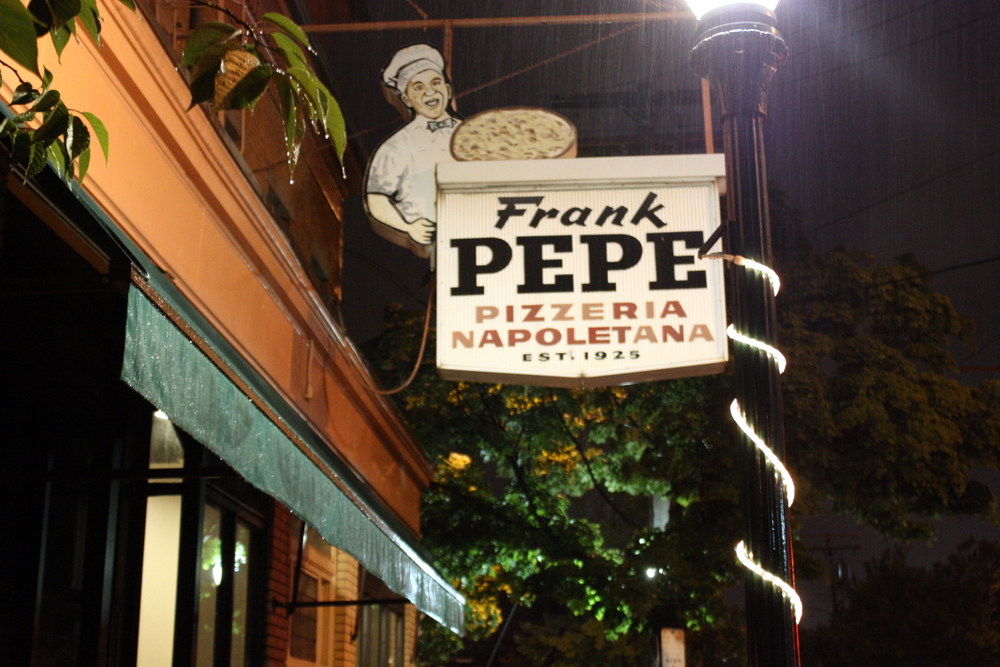Travel
A day in New Haven: Art, bells and of course pizza

Exterior of Frank Pepe’s Pizzeria at Wooster Street in New Haven, Conneticut. (Photo: Krista/Flickr)
NEW HAVEN, Conn.—You don’t have to go to Yale to have fun in New Haven. Best of all, you don’t have to pay Ivy League tuition prices. New Haven has lots of top-notch free attractions, from art museums to carillon concerts — though you will have to pay to try the city’s famous pizza.
Museums
There are two outstanding art museums near campus. At 1111 Chapel St., the Yale University Art Gallery’s collection includes Joseph Stella’s kaleidoscopic “Brooklyn Bridge,” Van Gogh’s desolate “Night Cafe,” a Yosemite landscape by Albert Bierstadt and Thomas Hart Benton’s “Weighing Cotton,” a 1939 depiction of African-American children and others in a field with bags of harvested cotton resembling bleached bones.
The Yale Center for British Art, 1080 Chapel St., offers works going back centuries, from portraits and landscapes, including masterpieces by J.M.W. Turner, to exotic depictions of Britain’s far-flung colonial empire. An exciting contemporary gallery features artists like Damien Hirst and David Hockney. Through Dec. 11, contemporary exhibitions include a show themed on Britain’s colonial legacy by British Nigerian artist Yinka Shonibare, who uses wax-printed fabric as a symbol of global trade and imperialism. Shonibare’s work is paired with art by other Brits exploring racial identity, including Chris Ofili’s etchings of black men in feathered ruffs.
Also on Chapel Street, The Study at Yale boutique hotel offers stylish accommodations.
Architecture
Both art museums are housed in important modernist buildings by famed architect Louis Kahn with sleek glass and steel exteriors. The gallery’s lobby ceiling is composed of complex tetrahedron shapes, while the British museum galleries are suffused with natural light.
Another stunning building, the Beinecke Rare Book & Manuscript Library, 121 Wall St., just reopened after renovations. Inside, light filters serenely through marble panels, softly illuminating the colored stone’s veins. A six-story glass tower houses thousands of antique volumes. Exhibits include a Gutenberg Bible and Audubon’s “Birds of America.”
In contrast to these modern structures, most campus buildings are Gothic-revival style, with towers, turrets and arches. Depending on your frame of reference, they’ll remind you of Harry Potter or Oxford.
Bells
Yale’s Guild of Carillonneurs plays everything from hymns to Broadway tunes on the 54 bells inside Harkness Tower. The magical tones ring out from the tower at 74 High St. twice daily, for a half-hour at 12:30 p.m. and an hour at 5:30 p.m. Request a tower tour at http://www.yalecarillon.org .
Food
New Haven is famous for pizza, with a longtime rivalry between Sally’s Apizza, 237 Wooster St., and Frank Pepe, 157 Wooster. Pepe’s opens at 11 a.m., Sally’s at 4 p.m., so you can sample both in one day. Both serve delicious thin-crust pizza made in coal-fired ovens, and both offer tomato pies as well as regular mozzarella cheese pizza (small pies, $9). Pepe’s is a bit spiffier than Sally’s and also serves an excellent salad of seasonal greens. Students like Yorkside Pizza, which is closer to campus, 288 York St.
New Haven has lots of metered street parking, but watch where you park on Wooster Street. I didn’t notice signs requiring residential permits, and got a $30 ticket near Sally’s.
Other popular eateries include Claire’s Corner Copia, a vegetarian cafe, 1000 Chapel St.; Union League Cafe, a French restaurant, 1032 Chapel St.; and Miya’s Sushi, 68 Howe St., whose chef is a James Beard-award nominee.
Louis Lunch, 263 Crown St., originated as a lunch wagon in 1895 and was recognized by the Library of Congress as the U.S. birthplace of the hamburger. Burgers are cooked medium-rare in antique cast-iron gas grills, served on white toast.
I’d heard that Louis doesn’t have ketchup, but just in case, I asked if I could get ketchup with a to-go order.
“It’s in the bag,” the counterman said.
“So it’s a myth that you don’t have ketchup?” I asked.
“It’s not in the bag,” he admitted. “But I didn’t want to yell at you.”
It wasn’t in the bag.
History
The Puritans founded New Haven in 1638 and laid the city out on a grid with nine squares. The central commons, New Haven Green, is a downtown park and National Historic Landmark. Yale has been here since 1718.
The Grove Street Cemetery, 227 Grove St., (open 9 a.m., last entry 3:30 p.m.), dates to 1796. Many old stones bear no inscription, the words worn away over time. Notables buried here include Eli Whitney, inventor of the cotton gin. A white marker memorializes several Africans who died in New Haven after being imprisoned for a rebellion and takeover of the Amistad slave ship in 1839.
Slavery’s legacy is still shaking things up in New Haven. You may encounter student protesters asking Yale to change the name of Calhoun College because alumnus John C. Calhoun was a strong defender of slavery.
East Rock Park
Soldiers’ and Sailors’ Monument, a tower near the summit of East Rock Park, can be seen from all over New Haven. The 1887 tower honours those who died in the Revolutionary War, the War of 1812, the Mexican-American War and the Civil War.
East Rock Park is a heavily wooded park and is popular with runners and bikers. Hikers use Giant Steps Trail to reach the summit. But you can also drive up for a panoramic view of New Haven all the way to the waters of Long Island Sound.





















